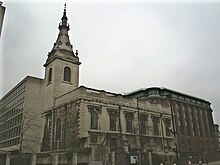St Nicholas Cole Abbey
| St. Nicholas Cole Abbey | |
|---|---|

Photo of St. Nicholas Cole Abbey
|
|
| Country | United Kingdom |
| Denomination | Church of England |
| Architecture | |
| Architect(s) | Sir Christopher Wren |
| Style | Baroque |
| Administration | |
| Diocese | London |
St. Nicholas Cole Abbey is a church in the City of London located on what is now Queen Victoria Street. Recorded from the twelfth century, the church was destroyed in the Great Fire of London in 1666 and rebuilt by the office of Sir Christopher Wren. The church suffered substantial bomb damage from German bombs during the London Blitz in the Second World War and was reconstructed by Arthur Bailey in 1961–2.
The church is named after the 4th century St Nicholas of Myra. “Cole Abbey” is derived from “coldharbour”, a medieval word for a traveller’s shelter or shelter from the cold. The church was never an abbey. The earliest reference to the church is in a letter of Pope Lucius II in 1144-5.
St Nicholas of Myra is patron saint of, among other groups, children and fishermen, and the church has special ties with both. An inventory of the church’s possessions taken at the time of the Protestant Reformation includes vestments for children, suggesting that the church maintained the tradition of electing a boy bishop on Saint Nicholas Day. Deeds in the reign of Richard I refer to a new fish market near St. Nicholas Cole Abbey. In a Charter of 1272, the church is referred to as ‘St Nick’s behind Fish Street’. During the 16th century, several fishmongers were buried here and John Stow records that during the reign of Elizabeth I, a lead and stone cistern, fed by the Thames, was set up against the north wall ‘for the care and commodity of the Fishmongers in and about Old Fish Street’.
As with all English churches, St. Nicholas Cole Abbey became Protestant during the Reformation. Upon the accession of Queen Mary I, it was the first church to celebrate Mass (on 23 August 1553). The incumbent rector, Thomas Sowdley, had obtained a licence to marry during the reign of Edward VI and was deprived of his living as a result. In the same month as the coronation of Mary I, John Strype recorded “Another priest called sir Tho. Snowdel, [i.e. Sowdley]whom they nicknamed "Parson Chicken", was carted through Cheapside, for assoiling an old acquaintance of his in a ditch in Finsbury field; and was at that riding saluted with chamber-pots and rotten eggs”. Sowdley regained his living on the accession of Elizabeth I.
...
Wikipedia
